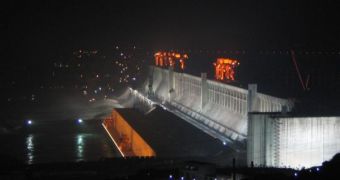China has finished building the largest hydroelectric plant in the world, the 7,661-foot-long Three Gorges Dam, on the Yangtze River, only for a short time. Elevated to the rank of national symbol, the dam has already come under criticism from environmentalists, who say that it may be a potent methane source. During the summer, as its 1,045-square-kilometer reservoir is half emptied, large areas of marshlands are formed. These terrains then start emitting methane at alarmingly high rates, experts say.
The Three Gorges Dam reservoir is impressive in size. When filled, it spans about 660 kilometers (410 miles) in length and 1.12 kilometers (0.70 miles) in width, on average. It also contains about 39.3 cubic kilometers (9.4 cubic miles) of water, which it collects from a catchment area of 1,000,000 square kilometers, or about 386,102 square miles. According to a new study, published in the latest issue of the respected Journal of Geophysical Research, the hydroelectric power plant, which is advertised as a green power source, is a living example of the adverse effects that some green technologies can indirectly have on the environment.
The reason why methane and carbon dioxide are released from marshlands is fairly simple. When the dam is closed for the first time, the area behind it floods with water, which covers grasslands, farm fields, forests and other vegetation. While submerged, organisms break the organic matter apart, and the methane is one of the byproducts for such a reaction. Once the water levels are lowered, soils that were once at the bottom of the lake begin to release the chemicals they have stored. The methane is very dangerous because it has about 20 times the warming potential of CO2, Nature News reports.
“Little attention has been paid to the drawdown regions, probably because they usually constitute a small part of the reservoir surface area,” Chongqing University ecologist Huai Chen, who is the first author of the new journal entry, explains. The drawdown area at this particular dam covers about 350 square kilometers, roughly a third of the total flooded area when the dam is operating at full capacity. In a study conducted on the marshes along the Pengxi River – a Yangtze tributary –, marshlands were found to be emitting as much as 6.7 milligrams of methane per square meter per hour. These rates are higher than those recorded in reservoirs located in tropical regions, where the emissions are the highest.
“This is an important study because it is the first careful look at greenhouse-gas emission from a major Chinese dam,” Stanford University energy-policy expert David Victor argues. “The research is a welcome addition to the current efforts in estimating methane emission by reservoirs around the world,” conservation biologist Philip Fearnside, from the National Institute for Research in the Amazon (NIRA), in Manaus, Brazil, concludes.

 14 DAY TRIAL //
14 DAY TRIAL //